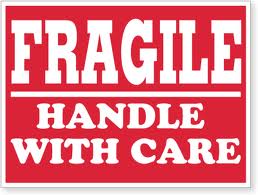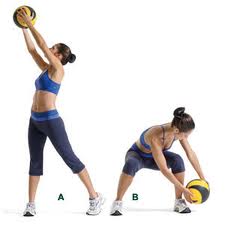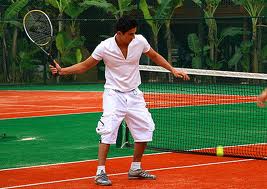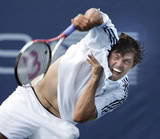Don't give injury a chance!
To avoid injury you certainly need a bit of luck, if you are an athlete. Such is sports science today, there is no question that injury avoidance is a lot easier. A personal trainer will understand your body and only give you routines that your body can safely tolerate. The problem is, we rarely have a personal trainer.

Coach - an injury preventer
We'll concern ourselves with two types of tennis injury, one which occurs from a shot, or persistent hitting of a shot. The other occurs from a general, often purely accidental, situation, and is very little to do with the fact that you were playing tennis when it occurred.

Injury precautions
I've had two serious injuries in tennis. The most persistent is tennis elbow. This first really became bad just as I stopped working in club tennis in 1996. I'm guessing a bit, but I did not have a regular coaching year at that time. I knew I was going to stop club coaching that autumn. I wasn't hungry for hours, and the hours I was doing were the last rites. I became lazy in my hitting and in my footwork, and when I hit balls with players, I hit off centre more and more often. The more off centre you hit, the more careful you become, and consequently the more off centre you hit. A real vicious circle, and by the time this period of a few months was over, my elbow was zinging with pain even with my arm hanging by my side. I effectively had to do a playing pause as a result of this for about a year. I wasn't coaching any more, but I still missed playing. The state of my arm made me frequently think that I would never hit a hard, properly-struck tennis ball again.
After a year I got back into it again with a selection of tennis bandages. It is well known that these bandages tighten up the muscle, cutting down on the reverberations into the joint and ligaments. It works. I still hit very hard balls today, but I am also still a tennis elbow sufferer. I can't play without a bandage. Ironically the bandage gives me so much confidence that I really do hit the ball as hard as I want. After a match where I've hit particularly hard, my arm is ready to drop off. The whole arm has been delivered with such strong shock tremors, that it isn't really hanging together any more.
The worst balls to hit the next day are the soft ones. They are excruciating. If I start whacking the ball again, I quickly forget the problem, and you'd never know that my elbow is beyond its sell-by date. The bandage has saved me. If I have to do some lifting at home (we have a wood burner at home) I put the bandage on again. I can do non-lifting tasks with no problem. One of my playing friends, of my age, had an operation on his elbow. I'm not sure exactly what they did to it, but I know that even though he is more comfortable after the operation, he still wears a bandage. He doesn't hit quite so brutally as I do.
Prevent injury from your tennis bag
The second injury had no real psychosomatic origins. In my early days in Germany I was discovering new surfaces and new ways of playing. I started hitting my services harder, and a little differently. I know today that I had some sort of knicks in it. I can only define a knicks as an unfortunate movement or tic somewhere in the action. I have no idea what it was exactly. My shoulder completely packed up. I can still remember the pain today when I was hitting my serves. It was doubly embarrassing because for a while I had to completely dismantle my service action and put it back together again. Luckily after a few months I had a better serve than ever! So maybe this was a blessing in disguise.
Clay - the ultimate tennis teacher
So these two are technical tennis injuries, the first I'm sure with a psychological element, the other purely mechanical.

Technique to avoid injury
Then little accidents happen. A couple of years ago I was playing on a sand court, turned to chase down a harmless drop shot, and pulled a stomach muscle. A year later I was playing a winter match, came in to net ready to volley which I tried to play a bit on the fly, that is taking a leap forward as I made contact. I made good contact, killed the ball, but as I landed just fell a bit wrong and pulled a thigh muscle. On each of these I had six weeks completely away from the game then another few weeks soft hitting to get back in shape again. Very frustrating.
Live healthy for tennis
These two types of injury are not really avoidable. They will happen. A technical injury is easier to avoid, but you really need someone monitoring your game all the time to make sure tics don't creep in. The little pulled muscles, which effectively lead to two months away from match tennis each time, are truly unfortunate. For my cases, on each occasion I was warm and fit, and it was a minor movement that set off the injury.
Any tips to combat injury?
Prevention starts with warming up. In my warming up video you will see players with a racket in the hand for warming up. This is the USPTR way and I never vary from it. It has served me well so I have no reason to do anything else. Other types of warming up - stretching, running, jogging, exercises, skipping are forbidden in my school. I have seen more injuries arise from incorrect warming up than from incorrect technique and accidents combined! Sometimes it can get serious, like the lady who broke her foot skipping a few years' back!
Of course all of these other exercises are part of a player's regime, but should be used only once he is fully warm.
One of my favourite parts of any tennis session is warming down. The drills are finished then the last few minutes we do something that has no intensity, with or without the racket. The body can handle anything when it is at running temperature.
Tennis movements can be extreme and specific, so I do recommend certain types of exercise for tennis players. It depends a bit on body type, but there are a few that would apply to all players. By doing these exercises regularly you avoid injury. Any irregularity in exercise or hitting routines increases the risk of injury. So if you are introducing a new movement, a new shot, it will be introduced very slowly, sometimes even in slow motion, so that the mind and the body understand exactly what is going on. Doing things at speed is further down the line, but by this stage the body is so used to the movement, and is in any case hot, so the risk of injury is slight.

Warmdown
Getting warm, staying warm are two essential controls for players. It can be a problem in winter as well as summer. A body can be too hot and too cold, and is no longer at "operating " temperature. The player must know how to keep that temperature where he wants it whatever the climatic and match conditions.
Finally, what is the best way to be prepared for that surprise movement, the accident? First, know your own game. Don't do things on the court you haven't practised from slow motion up. Second, participate in other sports. Make your body do things other than tennis movements. When that slam / dunk opportunity comes along, and you haven't practised it on the tennis court - at least you'll have practised it on the basketball court!
Play all sports
Have A Great Story About This Topic?
Do you have a great story about this? Share it!
